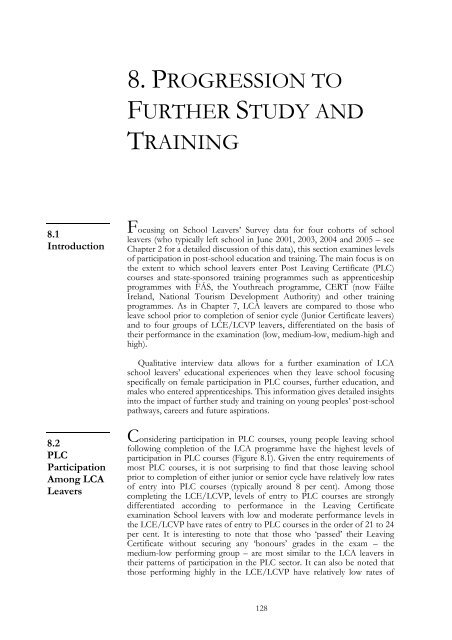Student Experiences of the Leaving Certificate Applied Programme
Student Experiences of the Leaving Certificate Applied Programme
Student Experiences of the Leaving Certificate Applied Programme
Create successful ePaper yourself
Turn your PDF publications into a flip-book with our unique Google optimized e-Paper software.
8. PROGRESSION TOFURTHER STUDY ANDTRAINING8.1IntroductionFocusing on School Leavers’ Survey data for four cohorts <strong>of</strong> schoolleavers (who typically left school in June 2001, 2003, 2004 and 2005 – seeChapter 2 for a detailed discussion <strong>of</strong> this data), this section examines levels<strong>of</strong> participation in post-school education and training. The main focus is on<strong>the</strong> extent to which school leavers enter Post <strong>Leaving</strong> <strong>Certificate</strong> (PLC)courses and state-sponsored training programmes such as apprenticeshipprogrammes with FÁS, <strong>the</strong> Youthreach programme, CERT (now FáilteIreland, National Tourism Development Authority) and o<strong>the</strong>r trainingprogrammes. As in Chapter 7, LCA leavers are compared to those wholeave school prior to completion <strong>of</strong> senior cycle (Junior <strong>Certificate</strong> leavers)and to four groups <strong>of</strong> LCE/LCVP leavers, differentiated on <strong>the</strong> basis <strong>of</strong><strong>the</strong>ir performance in <strong>the</strong> examination (low, medium-low, medium-high andhigh).Qualitative interview data allows for a fur<strong>the</strong>r examination <strong>of</strong> LCAschool leavers’ educational experiences when <strong>the</strong>y leave school focusingspecifically on female participation in PLC courses, fur<strong>the</strong>r education, andmales who entered apprenticeships. This information gives detailed insightsinto <strong>the</strong> impact <strong>of</strong> fur<strong>the</strong>r study and training on young peoples’ post-schoolpathways, careers and future aspirations.8.2PLCParticipationAmong LCALeaversConsidering participation in PLC courses, young people leaving schoolfollowing completion <strong>of</strong> <strong>the</strong> LCA programme have <strong>the</strong> highest levels <strong>of</strong>participation in PLC courses (Figure 8.1). Given <strong>the</strong> entry requirements <strong>of</strong>most PLC courses, it is not surprising to find that those leaving schoolprior to completion <strong>of</strong> ei<strong>the</strong>r junior or senior cycle have relatively low rates<strong>of</strong> entry into PLC courses (typically around 8 per cent). Among thosecompleting <strong>the</strong> LCE/LCVP, levels <strong>of</strong> entry to PLC courses are stronglydifferentiated according to performance in <strong>the</strong> <strong>Leaving</strong> <strong>Certificate</strong>examination School leavers with low and moderate performance levels in<strong>the</strong> LCE/LCVP have rates <strong>of</strong> entry to PLC courses in <strong>the</strong> order <strong>of</strong> 21 to 24per cent. It is interesting to note that those who ‘passed’ <strong>the</strong>ir <strong>Leaving</strong><strong>Certificate</strong> without securing any ‘honours’ grades in <strong>the</strong> exam – <strong>the</strong>medium-low performing group – are most similar to <strong>the</strong> LCA leavers in<strong>the</strong>ir patterns <strong>of</strong> participation in <strong>the</strong> PLC sector. It can also be noted thatthose performing highly in <strong>the</strong> LCE/LCVP have relatively low rates <strong>of</strong>128

















